Articles
- Page Path
- HOME > J Korean Acad Nurs > Volume 38(4); 2008 > Article
-
Original Article
- Economic Impact according to Health Problems of Workers
- Young-Mi Lee, Moon-Hee Jung
-
Journal of Korean Academy of Nursing 2008;38(4):612-619.
DOI: https://doi.org/10.4040/jkan.2008.38.4.612
Published online: August 31, 2008
1Post-doctoral Fellow, Department of Nursing, Osaka University, Osaka, Japan.
2Professor, College of Nursing, Hanyang University, Seoul, Korea.
- Address reprint requests to: Lee, Young-Mi. Department of Nursing, Course of Health Science, Graduate School of Medicine, Osaka University, 1-7 Yamadaoka Suita 565-0871, Japan. Tel: +81-80-1493-2747, Fax: +81-66879-2552, ymlyoon@naver.com
Copyright © 2008 Korean Society of Nursing Science
Abstract
-
Purpose
- The purpose of this study was to examine health problems and to estimate economic impact based on health problems of workers.
-
Methods
- The subjects of this study consisted of 301 workers who received a group occupational health service. Data was collected from February 1 to March 30, 2006. The questionnaire contained questions based on general characteristics and the Stanford Presenteeism Scale. Data was analyzed with descriptive statistics, t-test using SPSS program.
-
Results
- The primary health conditions as reported by workers were ranked in order as stomach or bowel disorders, back or neck disorders, or liver function disorders. The reason of absenteeism per worker was ranked in order as asthma, or a breathing disorder. The reason of presenteeism was ranked in order as asthma, insomnia or a sleep disorder. The cost of the total economic impact on the workplace in this study was 8,851,838 won. The cost of absenteeism per worker was 8,390 won. The cost of presenteeism per worker was 941,732 won.
-
Conclusion
- Presenteeism had a strong correlation to health conditions of the workers. Therefore, improving the work conditions of the workers is very important. If employers improve the health condition of workers, they will benefit from improved productivity in their business.
- 1. Boles M, Pelletier B, Lynch W. The relationship between health risks and work productivity. Journal of Occupational and Environmental Medicine. 2004;46:737–745.ArticlePubMed
- 2. Bramley TJ, Lerner D, Sarnes M. Productivity losses related to the common cold. Journal of Occupational and Environmental Medicine. 2002;44:822–829.ArticlePubMed
- 3. Burton WN, Chen CY, Conti DJ, Schultz AB, Edington DW. The association between health risk change and presenteeism change. Journal of Occupational and Environmental Medicine. 2006;48:252–263.ArticlePubMed
- 4. Burton WN, Chen CY, Conti DJ, Schultz AB, Pransky G, Edington DW. The association of health risks with on-the-job productivity. Journal of Occupational and Environmental Medicine. 2005;47:769–777.ArticlePubMed
- 5. Burton WN, Pransky G, Conti DJ, Chen CY, Edington DW. The association of medical conditions and presenteeism. Journal of Occupational and Environmental Medicine. 2004;46:S38–S45.ArticlePubMed
- 6. Cockburn IM, Bailit HL, Berndt ER, Finkelstein SN. Loss of work productivity due to illness and medical treatment. Journal of Occupational and Environmental Medicine. 1999;41:948–953.ArticlePubMed
- 7. Collins JJ, Baase CM, Sharda CE, Ozminkowski RJ, Nioholson S, Billotti GM, et al. he assessment of chronic health conditions on work performance, absence, and total economic impact for employers. Journal of Occupational and EnvironmentalMedicine. 2005;47:547–557.
- 8. Edington DW, Burton WN. McCunney RJ. Health and productivity. In: A Practical approach to Occupational and Environmental Medicine. 2003;3rd ed. Boston, MA, Little, Brown and Co. 140.
- 9. Gilmour H, Patten SB. Depression and work impairment. Health Reports. 2007;18:9–22.
- 10. Goetzel RZ, Long SR, Ozminkowski RJ, Hawkins K, Wang S, Lynch W. Health, absence, disability, and presenteeism cost estimates of certain physical and mental health conditions affecting U.S. employers. Journal of Occupational and Environmental Medicine. 2004;46:398–412.ArticlePubMed
- 11. Hump P. Presenteeism: At work-but out of it. Harvard Business Review. 2004;82:49–58.PubMed
- 12. Koopman C, Pelletier KR, Murray JF, Sharda CE, Berger ML, Turpin RS, et al. Stanford presenteeism scale: Health status and employee productivity. Journal of Occupational and Environmental Medicine. 2002;44:14–20.ArticlePubMed
- 13. International statistics: major statistical index of OECD. 2007;November-a;Retrieved November 26, 2007. Korea National Statistical Office. from http://www.kosis.kr/.
- 14. Employment:total economically active population according to gender and age. 2007;November-b;Retrieved November 16, 2007. Korea National Statistical Office. from http://www.kosis.kr/domestic/theme/do01_index.jsp.
- 15. Health: Health examination of workers. 2007;November-c;Retrieved November 16, 2007. Korea National Statistical Office. from http://www.kosis.kr/domestic /theme/do01_index.jsp.
- 16. Lang S. Economists coin term, 'presenteeism' for on-the-job health slow downs. 2005;Retrieved May 20, 2006. from http://www.news.cornell.edu/Chronicle/04/4.22.04 /presenteeism.html.
- 17. Middaugh DJ. Presenteeism: sick and tired at work. Medsurg Nursing. 2006;15:103–105.PubMed
- 18. Pelletier KR, Koopman C. Bringing health to the bottom line. Business & Health, Jun 15. 2003;June 15;Retrieved November 10, 2006. from http://managedhealthcareexecutive.modernmedicine.com/mhe/Absenteeism/Bringing-Health-to-the-Bottom-Line/ArticleStandard/Article/detail/134250.
- 19. Ruez P. Quality and bottom line can suffer at the hands of the working sick. Managed Healthcare Executive. 2004;14(11):46–48.
- 20. Sanderson K, Andrews G. Common mental disorders in the workforce: Recent findings from descriptive and social epidemiology. Canadian Journal of Psychiatry. 2006;51(2):63–75.ArticlePubMedPDF
- 21. Shamansky SL. Presenteeism or when being there is not being there. Public Health Nursing. 2002;19:79–80.ArticlePubMed
- 22. Testa MA, Simonson DC. Health economic benefits and quality of life during improved glycemic control in patientswith type 2 diabetes mellitus: A randomized, controlled, double-blind trial. The Journal of the American Medical Association. 1998;280:1490–1496.PubMed
- 23. Turpin RS, Ozminkowski RJ, Sharda CE, Collins JJ, Berger ML, Billotti GM, et al. Reliability and validity of the Stanford presenteeism scale. Journal of Occupational and Environmental Medicine. 2004;46:1123–1133.ArticlePubMed
- 24. Yamashita M. Influential factors on presenteeism in 3 enterprises. 2007;Osaka, Japan, University of Osaka. Unpublished master's thesis.
REFERENCES
Figure & Data
REFERENCES
Citations

- The Association Between Clinical Nurses’ Work Environment, Job Stress, and Health Locus of Control and Presenteeism in South Korea
Jin-Young Park, Yong-Sook Eo
Healthcare.2024; 12(22): 2293. CrossRef - Economic evaluation of acupuncture as an adjunctive treatment with usual care for mild-to-moderate knee osteoarthritis: A Markov model-based analysis
Eunhye Hyun, Byung-Cheul Shin, NamKwen Kim, Byungmook Lim
Integrative Medicine Research.2023; 12(3): 100982. CrossRef - Relationship between occupational stress, sleep disturbance, and presenteeism of shiftwork nurses
Jihyun Baek, Jison Ki, Jaegeum Ryu, Choi‐Kwon Smi
Journal of Nursing Scholarship.2022; 54(5): 631. CrossRef - Traditional medicine for the treatment of common cold in Korean adults: A nationwide population-based study
Hyungtae Kim, Jun-Yong Choi, Minna Hong, Hae Sun Suh
Integrative Medicine Research.2021; 10(1): 100458. CrossRef - Effects of an Integrated Physical Activity Program for Physically Inactive Workers: Based on the PRECEDE-PROCEED Model
Hye-Jin Kim, Jina Choo
Journal of Korean Academy of Nursing.2018; 48(6): 692. CrossRef - Perceived discrimination and low back pain among 28,532 workers in South Korea: Effect modification by labor union status
Nagyeong Lee, Hyoju Sung, Ji-Hwan Kim, Laura Punnett, Seung-Sup Kim
Social Science & Medicine.2017; 177: 198. CrossRef - Effectiveness of Workplace Interventions for Depression in Asia: A Meta-Analysis
Rebecca W. M. Lau, W. H. Mak
Sage Open.2017;[Epub] CrossRef - Associations between prevalence of adult atopic dermatitis and occupational characteristics
Yeunhee Kwak, Yoonjung Kim
International Journal of Nursing Practice.2017;[Epub] CrossRef - Effects of Oral Health Education for Occupational Health Nurses
Hyo-Jin Lee, Dai-Il Paik
Journal of dental hygiene science.2016; 16(1): 77. CrossRef - A Study on the Presenteeism of Call Center Workers in the Customer Service Business
Myung-Hee Jung, Hye-Sun Jung
Korean Journal of Occupational Health Nursing.2015; 24(2): 142. CrossRef - Impact of working environment on the subjective health symptoms in the dental hygienists
Ka-Young Jeong, Hye-Eun Cho
Journal of Korean society of Dental Hygiene.2015; 15(3): 539. CrossRef - Factors Influencing Health Promoting Behaviour according to the Type A/B Personality of White Collar Workers
Jin Yi Choi, Young Mi Park
Korean Journal of Occupational Health Nursing.2013; 22(4): 305. CrossRef - Effect of Workplace Health Manager's Role Performance on Presenteeism in the Workers
Myung-Hee Jung, Hye-Sun Jung, Bok-Im Lee
Korean Journal of Occupational Health Nursing.2013; 22(2): 171. CrossRef - Socioeconomic and Employment Status of Patients with Rheumatoid Arthritis in Korea
Jeong-Mi Kwon, Jinnie Rhee, Hyemin Ku, Eui-Kyung Lee
Epidemiology and Health.2012; 34: e2012003. CrossRef - Loss of Productivity due to Depression among Korean Employees
Young‐Mi Lee
Journal of Occupational Health.2010; 52(6): 389. CrossRef
General Characteristics of Workers (N=301)
Health Problems of Workers Who Experienced at Last 4 Weeks*
*Multiple response.
Absenteeism and Presenteeism of Workplace by Primary Health Conditionss
Absenteeism and Presenteeism according to General Characteristics
*p<.05; **p<.01.
Ecomonic Impact of Workplace by Primary Health Conditions at Last 4 Weeks (Unit=won)
Comparison of Economic Impact per One Worker at Last 4 Weeks (Unit=won)
**p<.01.
*Multiple response.
*p<.05; **p<.01.
**p<.01.
 KSNS
KSNS
 E-SUBMISSION
E-SUBMISSION
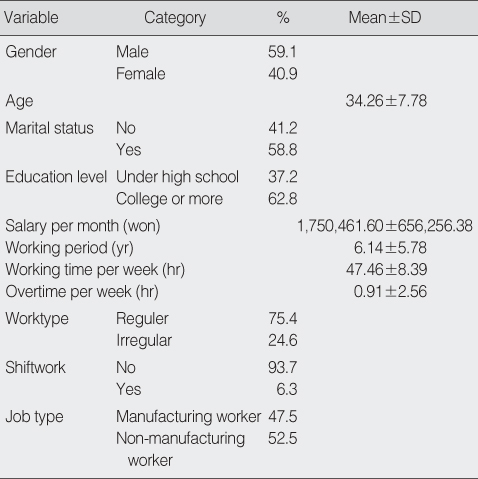
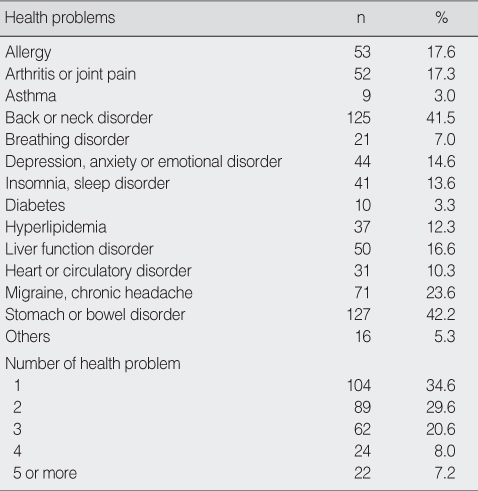
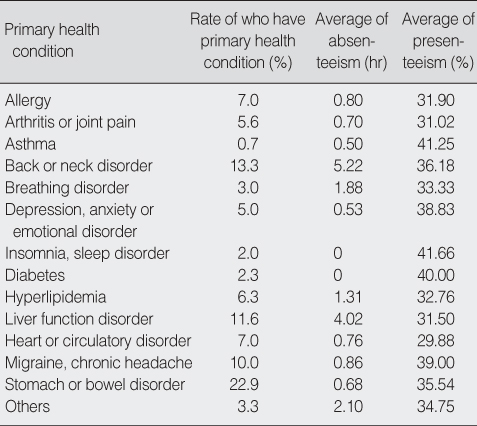
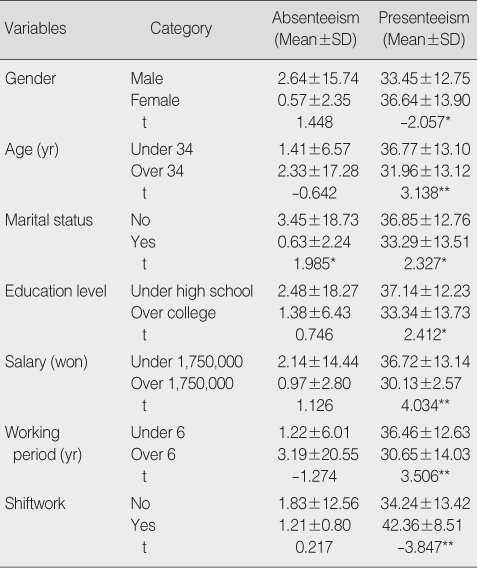
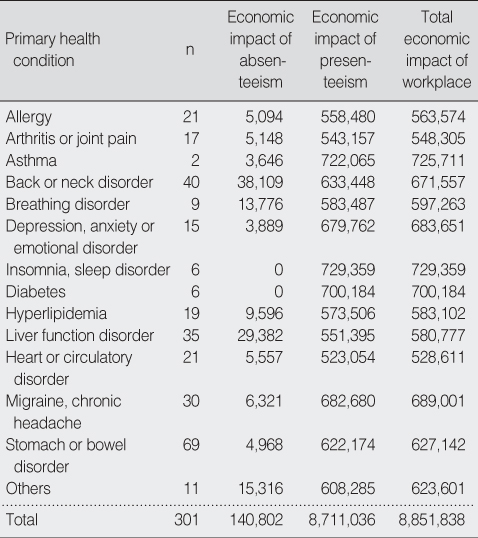
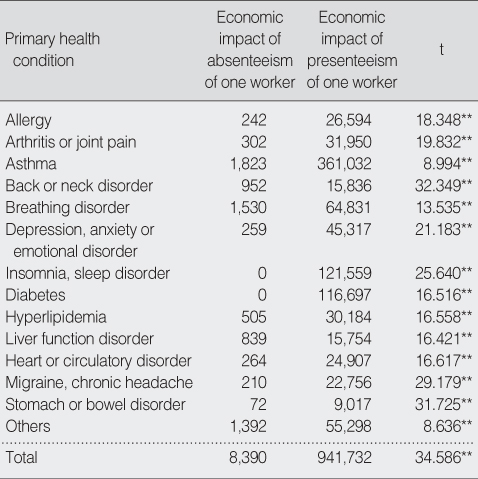
 Cite
Cite

